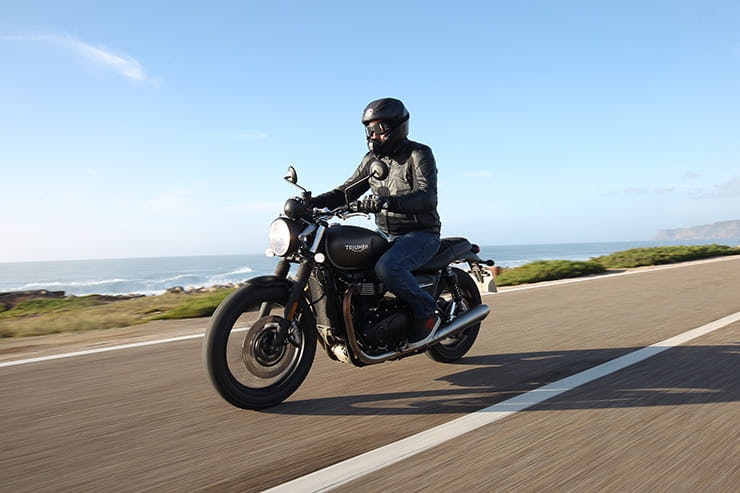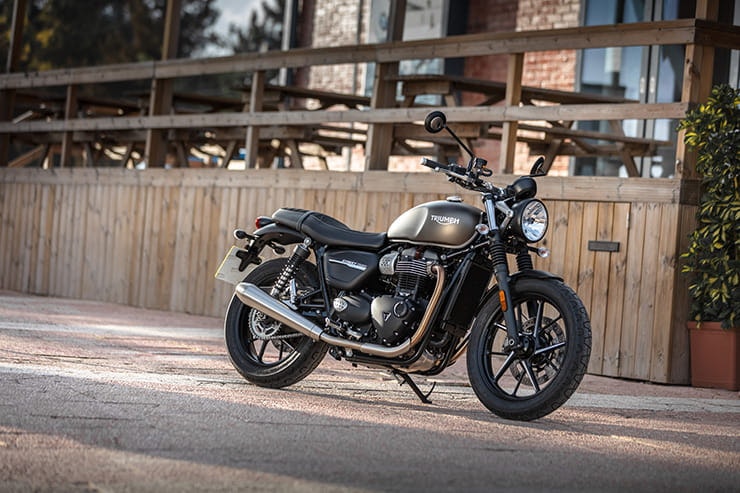Triumph Street Twin (2019) | Review
By Michael Mann
BikeSocial Managing Editor
21.11.2018
KIT CREDITS
They might not look very different but Triumph’s 2019 Street Twin hides substantial performance, electronic and styling upgrades compared to the outgoing version. Significantly, an extra 10bhp up to 64bhp thanks to an increase of peak revs, plus enhancements to the motor, electrics, suspension, brakes, comfort and design. Off we went to the international press riding launch just outside Portugal’s capital city of Lisbon to give it, and its stablemate the Street Scrambler, a whirl.
The Street Twin was launched in 2016 and has become one of Triumph’s most important models, outselling its own nearest modern classic rival by 2:1 thanks to its unintimidating style and accessibility.
Take a look at my first impressions of the two Triumph newbies:
2019 Triumph Street Twin and Street Scrambler - first impressions
First impressions of the 2019 Triumph Street Twin but do the upgrades justify it replacing the best-selling Triumph modern classic? | BikeSocial
Price
With a starting price of £8,100 for the Jet Black colour option plus a further £150 for the other two colour options of Korosi Red or Matt Ironstone, this represents a mere £300 price hike from the outgoing 2016 model. PCP packages have yet to be confirmed but by the time the bikes appear in UK dealerships from the end of January/beginning of February, the Street Twin will be a tasty option for those looking for an easy-to-ride, easy-to-operate slice of motorcycling pie.
Service intervals of 10,000 miles, the typical Triumph build quality and an average mpg north of 60 are other financial-based attractions.
Three colours on offer for the Street Twin
Power and torque
The same liquid-cooled, 900cc, parallel twin engine as the 2016 model has been more-than-just tweaked. An 18% increase in peak power up from 54bhp @ 5,900rpm to 64bhp @ 7,500rpm gives the new entry-level Triumph a heap of extra British beef from 3,750rpm over the old one.
Peak torque is unchanged at 59lb-ft, but arrives higher in the rev range at 3800rpm compared to 3230rpm previously. These improvements come from new camshafts, new balancer shafts and a lighter clutch.
There’s little chance the power and torque figures will be hard thought over when making a buying decision as the Bonneville-oriented Triumph is about style, comfort and convenience rather than pace and top trump statistics. However, the mid-range torque is a decent benefit when it comes to overtaking; twist the throttle and the leisurely twin accepts the challenge and smoothly takes you on your way. It’s all quite relaxed.
A dealer-fitted A2 licence kit which contains APS twist grip and engine tune is available and can be returned to normal once the appropriate licence is obtained.
Power and torque figures vs. the 2016 model
Engine, gearbox and exhaust
New engine internals include a new magnesium cam cover, new lightweight crankshaft, dead shafts and balance shafts and lighter clutch which all make the smooth liquid-cooled motor, harnessed by the crisp ride-by-wire throttle and refined fuelling, that bit better.
The 5-speed gearbox offers short, precise and reassuring clunk with every smooth change with top gear rarely used away from dual carriageways, it acts as an overdrive particularly as the Street Twin is designed and marketed as an urban bike.
There’d be no need for a 6th gear with the torque of the engine and the fact that it’s geared high already. At 30mph in 1st and you’re only pulling 3,000rpm, for example. It’s such an easy bike to ride. Even with the digital rev counter, there’s no red line because it’d so infrequently reached, there’s just no need for a bike that makes its peak amount of torque at 3,800rpm while peak power isn’t until 7,500rpm. In daily use, rarely will anything north of 5,500rpm is required.
The brushed exhaust system is beautifully designed and one of my favourite parts of the Triumph, from the headers to the low yet upswept silencers either side of the rear wheel. Not only does it offer a heritage Bonneville feel but the way in which the engineers have concealed the catalytic converter, like on several other models, is genius. Not only that, but the typical deep and chuggy melody of the twin is seemingly enhanced. It’s almost worth leaving the earplugs out.
Economy
A 12-litre tank is a piece of spec that shouldn’t be taken at face value. Don’t immediately picture yourself hunting for the fuel station every 80-miles or so. The claims might be a little excitable at 70+mpg but even on a ‘keen’ press, I still eeked out over 60mpg which, in the so-called real world riding conditions, means your search for a top-up should begin after 120-miles. The LCD screen offers a fuel gauge, predicted range plus average and current mpg figures, so there’s no excuse for the bike walk-of-shame.
Handling, suspension, chassis and weight
It’s flat cornering behaviour warrants a more attacking style while the new cast aluminium 18” front and 17” rear wheels, fitted with Pirelli Sports Comp rubber do their job without fuss. The new front KYB 41mm cartridge front forks and rear KYB twin shocks are this good; I didn’t even notice a bump, lump, dive or wallow on the press ride worthy of making any note. And Portugal’s roads aren’t famed for their first class smoothness and tarmac quality!
Brakes
One of the better upgrades for 2019 is the replacement of the twin-pot Nissin caliper on the front, single, 310mm disc with a four-piston Brembo version. And you can tell the difference with better feel through the lever combined with those new front forks for less dive.
Comfort
The essence of this motorbike is a heritage look and modern day reliability and engineering all in a package that is manageable for every type of rider. Young or old, first bike, tenth or bike, only bike or part of a fleet, city rider or back lane cruiser… anyway you get the jist, the low seat height and narrow waist between fuel tank and saddle plus balanced weight and controllable chassis makes the Street Twin a real yet perhaps understated coup. Not many would think about a 900cc engine for an A2 licence holder.
The seat height has been increased by 10mm to 760mm courtesy of an increase in seat foam thickness to improve the riding position. Which suits me just fine because at 6ft tall I needed that extra space for my legs.
Equipment
For such a simple looking machine with basic dials and instrument, beneath lies a raft of kit. New Road and Rain riding modes adjust throttle map and traction control settings and are easily switchable via the press of one ‘Mode’ button on the left-side of the switchgear. That , which incidentally should be rotated back towards the rider for a little extra comfort and ease to access switches – I found myself having to look down too many times to make sure I was about the indicate rather than hoot anyone or change the riding mode instead. In addition, ABS and traction control can be switched off, not while on the move though, while a new accessory tyre pressure monitoring system adds peace of mind.
An LED rear lights, immobiliser with key fob-based transponder and a handy USB charging socket under the seat are all handy rider-focused tech while the redesigned single dial instrument panel is packed with info all operational via the on ‘i’ button, also located on the left-side of the bars.
Rivals
Royal Enfield’s new-for-2019 Interceptor 650 is 17bhp down on power compared to the Triumph but is an attractive £2,600 cheaper. Also new for the coming model year is Kawasaki’s reborn W800 not much in the way of specs yet but we do know it’s the air-cooled 773cc parallel twin which will be capped at 47bhp to make it A2-licence friendly.
The Yamaha XSR700 XTribute was unveiled at EICMA and houses the familiar 689cc liquid-cooled parallel twin making 74bhp although there’s no word on price yet. And finally, the Ducati Scrambler Icon that includes some higher tech and is slightly less retro, it makes 72bhp, has a 38mm taller seat but an almost identical price to the Triumph.
2019 Triumph Street Twin verdict
Retro style mixed with modern tech and engineering substance is a sure-fire winner and we’ve seen Triumph conquer this concoction before. This time, the Street Twin has got to that next step up without any fuss. It’s priced sensibly, comes with a robust chassis and engine combo and provides an elegant and classy if not easy and unthreatening entry point. Impressively simple to get on with, allowing the rider to almost forget they’re riding.
An accessory range of more than 140 dealer-fit options to customise your pride and joy from mudguard removal kits and fly screens to luggage and silencer options, there’s plenty to choose from using the rather clever online configurator. There’s even two inspirations kits, known as Urban Ride and Café Custom if you need some help deciding.
Three things I loved about the 2019 Triumph Street Twin …
* Such an easy bike to get on with – beautifully fuelled and a light clutch
* Low seat height
* Superb attention to detail, e.g. exhaust routing
Three things that I didn’t…
* Steering is a bit weighty
* Left-side instruments and clutch lever need rotating backwards by a few degrees
* Still a little heavy for an “introductory” bike (+30kg over a 790 Duke, for example)


